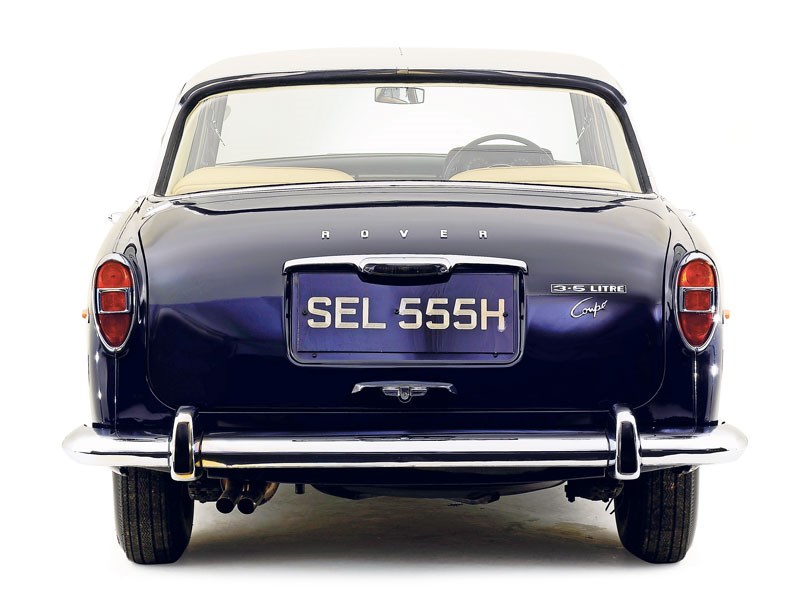A quintessentially British luxury saloon, the Rover P5B is well worth a closer look.
The P5B is all about one thing and that’s comfort. It starts with a luxurious and well-appointed cabin that is a fine place to while away the miles; this is a car that can cover long distances without putting any strain on the driver or passengers. Settled into the comfy leather chairs and with a light grip on the thin-rimmed wheel, you’re all ready to enjoy everything the stylish Rover has to offer. Finger-light steering and a cosseting ride make covering big miles a relaxing affair, and while B-road heroics are strictly off the menu, this is exactly what you’d expect from this fine British car. The P5B is no sluggard, though, despite a hefty kerb weight – the smooth, torquey V8 engine is more than capable of providing a decent turn of pace, although making the most of that performance will come at the expense of eye-watering fuel consumption. Stopping is no problem either, as the brakes respond strongly to the lightest of pedal pressure, and are more inspiring than the slightly lacklustre steering. A wonderful way to travel, though.
VITAL STATISTICS
Rover P5B
Engine 3528cc/V8/OHV
Power (bhp@rpm) 160bhp@5200rpm
Torque (lb ft@rpm) 226lb ft@3000rpm
Top speed 110mph
0-60mph 10.7sec
Consumption 17.2mpg
Gearbox 4-spd manual/4-spd auto opt.
WHAT TO LOOK FOR
BODYWORK & CHASSIS
The Rover V8 is a tough unit and easily capable of 150,000 miles or more. Regular changes of oil and antifreeze are the key, but also check for signs of overheating that could lead to head gasket failure. Radiators will fur-up and leak over time, so a bill for a replacement is a good sign. Oil leaks from the engine block and gearbox can be a niggle but are often caused by blockeded breathers, so check there first. Early cars were fitted with a low-volume oil pump, so fitting one from the Rover SD1 engine is a useful mod. Ticking from the camshafts and hydraulic tappets when the engine is warm mean a top-end re-build is probably overdue. Listen for leaks from the exhaust manifold as securing nuts can work loose. Auto chokes can give trouble so manual conversions are common. Listen for pinking as these engines should run on Five Star petrol.
The complex three-piece sills can rot badly (particularly around the jacking points) so it pays to dig deeper even if things appear fine, and you should also check the front and rear inner wings and the boot floor. Pay close attention to wheelarches, door bottoms and the rear valance, as well as the door pillars. The base of the D-pillar can rot where it meets the rear wheelarch, so check around the end of the sill/kickplate with the door open. Inspect for even panel gaps and ensure the doors don’t sag when open. Bubbling under the front and rear screen rubbers is bad news as rot is costly to repair.
RUNNING GEAR
An automatic gearbox was standard on the P5B – Borg Warner DG on early models, BW 35 later on – and both are reliable as long as they aren’t abused. Blackened or burnt-smelling fluid suggests potential problems. Rear axles are considered bombproof, so any issues will be apparent on a test drive, as will a vibration caused by a worn propshaft centre bearing – the latter is a cheap fix, though.
The rest of the running gear is fairly straightforward and unlikely to cause problems if well maintained. Look out for worn shock absorbers and sagging rear leaf springs, along with any rot around the mountings for the front torsion bar springs. Little-used examples could be in need of a brake overhaul so check for corroded brake pipes or seized handbrake mechanisms. The power steering system is prone to leaks from seals or the steering box; some owners fit an uprated box that is available from specialists. The Rostyle wheels are specific to the P5B so ensure these are still fitted – they can be refurbished at a reasonable cost if need be.
BRAKES
If we haven’t put you off already, there’s one more hidden area to examine for corrosion. This is the ledge on the bulkhead that supports the brake servo. Debris accumulates here and, especially if combined with leaking brake fluid, can cause the metal underneath to rot through.
INTERIOR
The cabin of a P5B needs to be in good condition if an expensive resto is to be avoided. Rover used high quality leather, carpets and wood veneers so check for wear and tear or any water damage. Also check that the instruments are working correctly – the window winders on coupés are a notorious weak point.
OUR VERDICT
This is old-school British luxury as its very best, and should feature on the list of any buyer looking for a comfortable and stylish classic. Whether you pick the saloon or the coupé, the lovely interior and woofling V8 engine are the stars here, but as with any car of this age you do need to buy carefully. Condition is everything with the P5B and returning a restoration case to its former glory can easily soak up huge amounts of cash, so enlisting the help of a specialist to help you find the right car is a sensible move.



